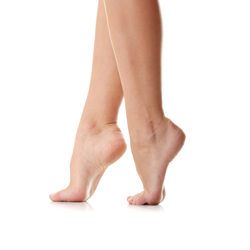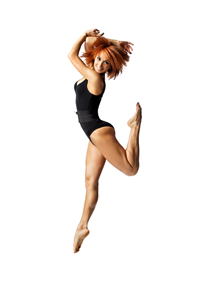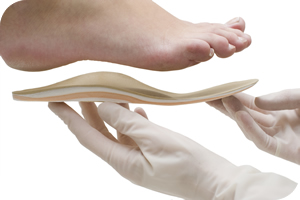Lateral Foot Pain – Cuboid Syndrome
 Cuboid syndrome is a condition that causes lateral foot pain. In forty percent of cases Cuboid syndrome is associated with lateral ankle sprains (inversion sprain). This syndrome affects the joint (capsule), ligaments, and tendons (peroneus longus tendon).
Cuboid syndrome is a condition that causes lateral foot pain. In forty percent of cases Cuboid syndrome is associated with lateral ankle sprains (inversion sprain). This syndrome affects the joint (capsule), ligaments, and tendons (peroneus longus tendon).
This syndrome is defined as a “minor disruption or subluxation of the structural congruity of the calcaneocuboid portion of the midtarsal joint”. In laymen’s terms, the cuboid bone has moved from its normal position in the joint.
It is a common syndrome, but not well-recognized by practitioners. Cuboid syndrome also goes by several other names: subluxated cuboid, dropped cuboid, cuboid fault syndrome, and lateral plantar neuritis.
Anatomy/Biomechanics
The calcaneocuboid joint is a vital link in lateral foot stability. This joint is susceptible to sudden injury or chronic strain, which can cause this joint to partially dislocate or subluxate.
The cuboid bone is one of the seven tarsal bones of the foot.
Joint Anatomy: The cuboid articulates with the fourth and fifth metatarsals forming a joint (tarsometatarsal joint). It also articulates with the heel bone (calcaneus), forming a joint (calcaneocuboid joint). On the inside (medially) the cuboid articulates with two bones (lateral cuneiform and the navicular). An alteration of the cuboid can have a considerable effect on the joint biomechanics of the foot.
If we were to view the bottom of the cuboid bone we would see a groove where the tendon of the peroneus longus muscle runs along it.
Peroneus Anatomy: The peroneus longus muscle originates on the lateral lower leg (upper one-third of the fibula). It then runs down around the outside of the ankle (lateral malleolus) then through the grove on the bottom of the cuboid. It then inserts into the base of the first metatarsal (and cuneiform).
The peroneus longus acts as a stabilizer of the forefoot. The cuboid bone acts as a pulley which increases mechanical advantage for the peroneus longus muscle.
 Causes
Causes
A single impact injury or repetitive motion can cause this syndrome to occur. Runners and dancers (especially ballet dancers) are susceptible to this injury because of the high levels of repetitive impact. In addition basketball players or racquet sport players also are susceptible due to the lateral motions required to play these sports.
If a person abnormally pronates their foot during the push off phase of gait, they will be more susceptible to a cuboid injury. Excessive pronation causes an increase in force transferred to the cuboid bone which causes instability and a resultant injury.
Symptoms
Patients who have cuboid syndrome often complain of lateral foot pain, or weakness in their feet. Pain from cuboid syndrome can also radiate to the front of the ankle. This pain is often more noticeable during time of exertion (toe-off portion of the gait cycle), or on impact.
The type of pain found in cuboid syndrome may not be a very good indication of this condition.Pain can be intermittent, or persistent, it can also develop suddenly or slowly over a period of time.
 Diagnosis and Imaging
Diagnosis and Imaging
Upon physical examination, the patient may have pain directly over the cuboid bone (especially when pressure is applied dorsally on the plantar surface). In some cases there may be bruising, redness and swelling. Range of motion in the ankle is often limited in cuboid syndrome (dorsi and plantar flexion).
X-rays, CT scans or MRIs are of little value in the diagnosis of cuboid syndrome. The only reason an X-ray is of value in the diagnosis of this syndrome is to rule out fractures or some type of pathological condition.
Treatment
Several forms of manual therapy can be used in treating this condition. The sooner that treatment is implemented the faster the results will be.
Manipulation: One of the most successful treatments we have found is manual manipulation. A therapist training in extremity manipulation (chiropractor, physiotherapist, podiatrist) can often reduce the pain of cuboid syndrome in a short period of time.
Soft tissue techniques: Techniques such as Active Release, Graston, Massage Therapy, and Fascial Manipulation can also be of great help. The key is to work with all of the structures involved in the kinetic chain, not only at the site of pain. These structures could be anywhere from the foot right up to the hip.
- For example we know that the peroneus longus muscle is involved in plantar flexion of ankle, and that this greatly affects cuboid stability. A problem with the peroneus longus could create an alteration in the normal plantar flexion movement. Even though the peroneus longus is most likely involved in this injury, we cannot take it for granted that this is the only plantar flexor affected. Treatment of all plantar flexors and their antagonist muscles, the dorsi flexors, is often needed for a full resolution.
- Plantar flexors: Calf muscles (Gastrocnemius & Soleus), Tibialis Posterior, Flexor Digitorum Longus, Flexor Hallucis Longus, Peroneus Longus, Peroneus Brevis, and Plantaris.
- Dorsi flexors: Tibialis Anterior, Extensor Digitorum Longus, Extensor Hallucis Longus.
 Exercise: Exercises should focus on stretching the peroneus longus and the calf muscles. These stretches are combined with strengthening the extrinsic muscles of the foot. In addition, it is essential to perform balance exercises so that the injury does not reoccur.Please go to www.releaseyourbody.com for a specific exercise needed to rehabilitate this injury.
Exercise: Exercises should focus on stretching the peroneus longus and the calf muscles. These stretches are combined with strengthening the extrinsic muscles of the foot. In addition, it is essential to perform balance exercises so that the injury does not reoccur.Please go to www.releaseyourbody.com for a specific exercise needed to rehabilitate this injury.
Orthotics: Custom fit orthotics will help to correct abnormal pronation and supinationthat may be leading to cuboid syndrome.
If you would like more information or to purchase our books please go to www.releaseyourbody.com .
If you would like information about our clinic in Calgary Alberta please go to www.kinetichealth.ca.
(COPYRIGHT KINETIC HEALTH 2012 – ALL RIGHTS RESERVED)

Leave a Reply